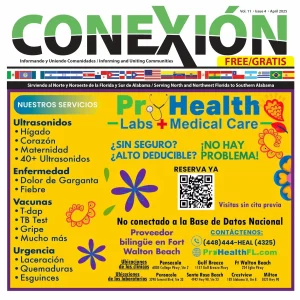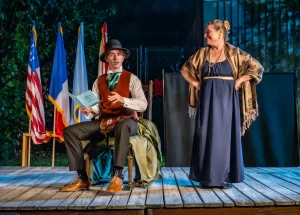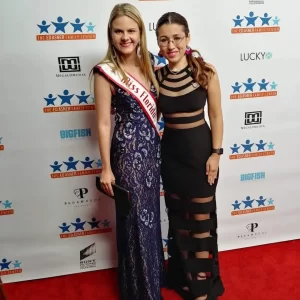Come in Houston: The Mosaics have Landed!
By Deborah DeSilets
In a city, not to far away, in another building for a by-gone era, there was an artist who drew and placed mosaics one by one upon curving walls to depict the twelve great discoverers of North American Continent. With each square unfolded a history. And the building that rose around this art, it with each wave upon wave, up from the sea, was the most spectacular hotel in the world—The Americana at Bal Harbor, Florida 1957, designed by the infamous architect, Morris Lapidus served as the “Gateway to America” for tourists vacationing here. It was a new type of hotel—a destination resort hotel—and destined the city of Bal Harbor, Florida as a tourist mecca. Artist from throughout the world came to make great art for this building. These artists crafted art that celebrated the exploration and discovery of the Americas. Renowned WPA muralist, and future Smithsonian artist, Anton Refregier was commissioned to create images of statesmen and explorers important to the Americas. Rather than employing traditional paints, Refregier used glass mosaic tiles in a painterly way to create the twelve, 23’ high x 4’ wide images to fill two flanking circular walls separated by the entry walkway into the Bal Masque Ballroom.
During the 2007 demolition of the Americana Hotel, the 1957 Anton Refregier Mosaics were discovered beneath a wall. Work stopped. Rescued from the previous renovation in the 1980’s, were six of the original mosaics that, Jorge Perez, the developer, instructed a team to see the art mosaics skillfully chiseled from the masonry walls, carefully lowered from their vertical positions unto an awaiting six beds of pallets that were each reinforced to hold a 2,000 lb, 3’ x 14 ‘the concrete masonry wall-encapsulated art mosaics. I was there at the discovery and have stayed present through all these years watching as Tallahassee, the Capitol City and my hometown has waited to act. Now it is the time to revisit these mosaics as new paintings depicting the cartouches used to develop these mosaics have been discovered by the family of Anton Refregier. Now the Refregier Estate, can add to the continuing story of the six Explorer Mosiacs by their grandfather, Anton Refregier which after such careful recovery, storage, and vetting process for placement in the State of Florida, they were graciously accepted, by the State Capitol City, Tallahassee, on July 12, 2011.
On May 1, 2019, Mayor Dailey expressed an interest in placing them in the capitol city on Jefferson Street’s Millennium walkway. Hurray! The mosaics have landed. In 2011 Democrat staff writer TaMaryrn Waters reported, “Tallahassee City Commissioners gladly accepted an offer by Starwood Resorts & Hotels to bring the mosaics to Tallahassee…” Further stating, “… Kay Stephenson, a board member for the Council on the Culture & Arts (COCA) and Gil Ziffer, City Commissioner reported on having seen the art in the Americana Hotel in Miami Beach” during their heyday. “Originally, 12 murals (sic mosaics) graced the entry to the Bal Masque Ballroom at the Americana Hotel…Discussions for bringing the murals to Florida’s Capital began about four years ago, and a string of key people have played a role.”
The leadership following in the years from 2012-2017 did not rally behind the idea for their placement. By 2017, myself and other concerned citizens for the arts in Tallahassee held a party sponsored by Conexion magazine. Why Conexion? One of the founders of Conexion Magazine knew of the twelve mosaics from childhood and wanted to see the remaining art restored. The party was held at the John Martin House, and was titled “Off the Wall”. The gathering of people celebrated the artistry and memory of the mosaics at the Americana Hotel (that began the initiative for public art) while family, friends and locals in the arts offered support. The party was a success; and soon following an art museum began to celebrate their history in the arts as well. It was the art of Jacques LeMoyne, for whom LeMoyne Art Gallery is named, that first showed to the courts of France and Spain the native people of the America’s; exhibiting the customs, style and culture of Native American people. It was Lemoyne’s art that relayed the message of the new world—an exotic new world called La Florida— to Europe. In celebration of their heritage Lemoyne’s Chain of Parks glorifies this history with a life-size painting of Jacques LeMoyne painted on plywood sets for locals to poke a head through and smile for the camera!
Tallahassee has a political and cultural relationship with art and architecture; from LeMoyne in 1500’s to the Letchworth Love mounds built before the Pyramids and Stonehenge; the fall and rise of civilization is told in Florida its arts, artifacts, culture and peoples. The discovery of the rescued explorers can remind the constituency of our own sense of discovery—and explorations upon wooden ships (Carrabelle hosted the fleet of Columbus’s ships in their port recently) —to rocket ships that blast into galaxies unknown. We, as Floridian, are a part of this history of exploration. We are still vital contributors to the ongoing age of discovery that requires exploration. The panhandle will see the Space Coast provide the future with more untold gifts of inquiry than there is space to write about. There is always a competition for money and for defining what has value to a society: but it is a firm fact that if not for the raw human desire to explore we would not have gotten to where we are today. Indeed, advocacy for the arts that depict exploration can not fail to appeal to our State’s citizenry for whom exploration and innovation is ingrained in our psyche. A special interest in the arts that expresses exploration symbolizes hope incarnate in a blazing array of light. This light gives Floridian’s an opening to dream. That art of this type summarizes and condenses our expression of exploration—through hard times, through good times, throughout calamity—Florida does not fear.
California has the Rincon Center, where Anton Refregier has for decades informed folks and tourists of the history of California. Having facilitated the coming of the mosaics to Tallahassee, I am convinced with proper understanding, public interest and political will can find the funding to have art of this caliber restored. Currently, The Smithsonian and conservators are working to catalogue rare findings of Anton Refregier willed to his daughter, in that collection an image (seen here and printed with the permission of the Refregier Estate) is the painting from which the making of the mosaics was achieved. There is yet more to be discovered about the glass in the collection: where it was from and by whose hand. It is a little-known fact that glass beads, now catalogued by the State at San Luis, were the first form of currency with the native tribes and DeSoto—the finding of glass beads marked his trail in Florida—held also at the Martin House off Lafayette Drive. Glass continues to shape our world—windows guard hurricane winds and brighten our homes. It is amazing to think that if the fire and might that it takes to shape glass could be rallied to support a glass art piece of this magnificence how far these explorers would go. These art pieces were designed for art in architecture before there was an art in public places commission; they were done for the people, because the people wanted art in their world that shared with others the history of their world. They were for 30 years placed in such a way as to be a “Gateway to the Americas”. Surely placed well today they could be a Gateway to Discovery for Florida’s tourist.
Tracy E. Danes wrote in closing his book on Claude Pepper and Ed Ball: Politics. Purpose and Power: “Implicit in the (political) process is the fact that the public interest is, at any given point, nothing more than a mosaic of currently prevailing special interests.” Let’s hope the mosaics of Anton Refregier have now found a place in the arts of Tallahassee—Now, Let’s explore that!



